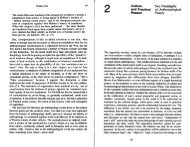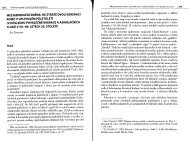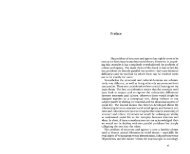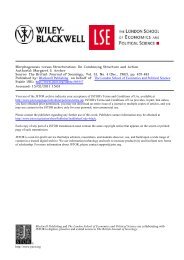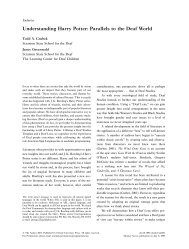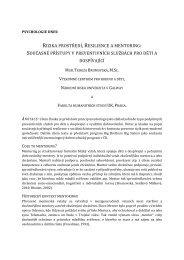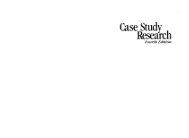The Social Construction of Disability - Moodle
The Social Construction of Disability - Moodle
The Social Construction of Disability - Moodle
You also want an ePaper? Increase the reach of your titles
YUMPU automatically turns print PDFs into web optimized ePapers that Google loves.
~ <strong>The</strong> Rejected Bodyvalue; having a damaged leg probably evokes the metaphorical meanings <strong>of</strong>being'crippled ' which include helplessness, dependency, and pitifulness.'Stigma, stereotypes, and cultural meanings are all related and interactive inthe cultural construcuon <strong>of</strong> disability. I will discuss them, and some <strong>of</strong> theirsocial consequences, more extensively in chapter 3.<strong>The</strong> power <strong>of</strong> culture alone to construct a disability IS revealed 'when weconsider bodily differences-s-devianons from a society's cunception <strong>of</strong> a'normal' or acceptable body-that, although they cause little or no functionalor physical difficulty for the person who has them, constitute majorsocial disabilities. An important example is facial scarring, which is a disability<strong>of</strong> appearance uuly, a disability constructed totally by stigma andcultural meanings." Stigma, stereotypes, and cultural meanings are also theprimary components <strong>of</strong> other disabilities, such as mild epilepsy and nothaving a 'normal' or acceptable body SIzeI believe that culture plays a central role in constructing (or not constructing)disability. However, I want to distll1guish this view fromapproaches to cultural construction <strong>of</strong> 'the body' that seem to confuse thelived reality <strong>of</strong> bodies with cultural discourse about and representations <strong>of</strong>bodies, or that deny or ignore bodily experience in favour <strong>of</strong> fascinationwith bodily representations. II For example, this approach troubles me inDonna Haraway's "<strong>The</strong> Biopolitics <strong>of</strong> Postmodern Bodies: Constitutions <strong>of</strong>Self in Immune System Discourse" (Haraway 1991 I, where Haraway discussesthe biomedical coristr uction <strong>of</strong> "immune system discourse" asthough discourse and its political context are all there is, without acknowledgmgeither the reality <strong>of</strong> physical suflering (for example, by people withAIDS, ME, MS, Amyotrophic Lateral Sderosis (ALS) , rheumatoid arthritis),which surely has some relationship to the development <strong>of</strong> immune systemdisroursr-, or the effects <strong>of</strong> this discourse on the lives <strong>of</strong> people who arethought to be suffenng from I!11l1lUne disorders.I do not think my body is a cultural representation, although I recognizethat my experience <strong>of</strong> it is both highly interpreted and very influenced bycultural (including medical) representations Moreover, I think it would becruel, as 'sell as a distortion <strong>of</strong> people's lives, to erase or ignore the everyday,practical, experienced limitations <strong>of</strong> people's disabilities simplybecause we recognize that human bodies and their varied conditions areboth changeable and highly interpreted That I call imagine having an energetic,pain-free body or liVing in a society where my body is consideredacceptable or normal and its limitations are compensated by social ando- physical arrangements does not make it any easier to get out <strong>of</strong> bed or totJ<strong>The</strong> <strong>Social</strong> <strong>Construction</strong> <strong>of</strong> <strong>Disability</strong> ~function as an academic III my present circumstances. In most poo;t!11oderncultural theorizing about the body, there is no recognitiun <strong>of</strong>--and, as faras I can see, no room for recognizing-tire hard physical realities that arefaced by people with disabilities. (Or would postmodernists deny that thereare sue h 'realities: suggestive as they are <strong>of</strong> something that is not constructedor constituted by discourse" I cannot tell, because nothing like it ISdiscussed.) <strong>The</strong> experiences <strong>of</strong> people WIth disabilities are as invisible in thediscourses <strong>of</strong> posnnoderuism. which has the virtue uf being critical <strong>of</strong> idealized,normalized, and universalized representations <strong>of</strong> bodies, as they arein discourses which employ concepts <strong>of</strong> bodily 'normality' uncritically II believe that in thinking about the social construction <strong>of</strong> disability weneed to strike a balance between, on the one hand, thinking <strong>of</strong> a body'sabilities and limitations as given by nature and/ or accident, as immutableand uncontrollable, and, on the other hand, thiuking <strong>of</strong> them as so constructedby society and culture as to be controllable by human thought,will, and action. We need to acknowledge that social justice and culturalchange can eliminate a great deal <strong>of</strong> disability while recugnizing that theremay be much suffering and limitation that they cannot fix<strong>Social</strong> Deconstruction <strong>of</strong> <strong>Disability</strong>In my view, then, disability is socially constructed by such factors as socialconditions that cause or fail to prev'ent damage to people's bodies; expectations<strong>of</strong> performance; the physical and social organization <strong>of</strong> societies onthe basis <strong>of</strong> a yUllng, non-disabled, 'Ideally shaped,' healthy adult male paradigm<strong>of</strong> citizens; the failure or unwillingness to create ability amongcitizens who do not fit the paradigm; and cultural representations, failures<strong>of</strong> representation, and expectations. Much, but perhaps not all, <strong>of</strong> what canbe socially constructed can be socially (and not just intellectually) deconsrrucu-d , given the means and the wil].A great deal <strong>of</strong> disability can be prevented with good public health andsafety standards and practIces, but also by relatively minor changes in thebuilt environment that provide accessihility to people wuh a wide range <strong>of</strong>physical characteristics and abilities Man}' measures that are usually regardedas helping or accommodating people who are novv disabled, such asmaking buildings and public places wheelchair accessible, creating andrespecting parking spaces for people with disabilities, prOViding AmericanSign Language translation, captioning, and Telephone Devices for the Deaf,



